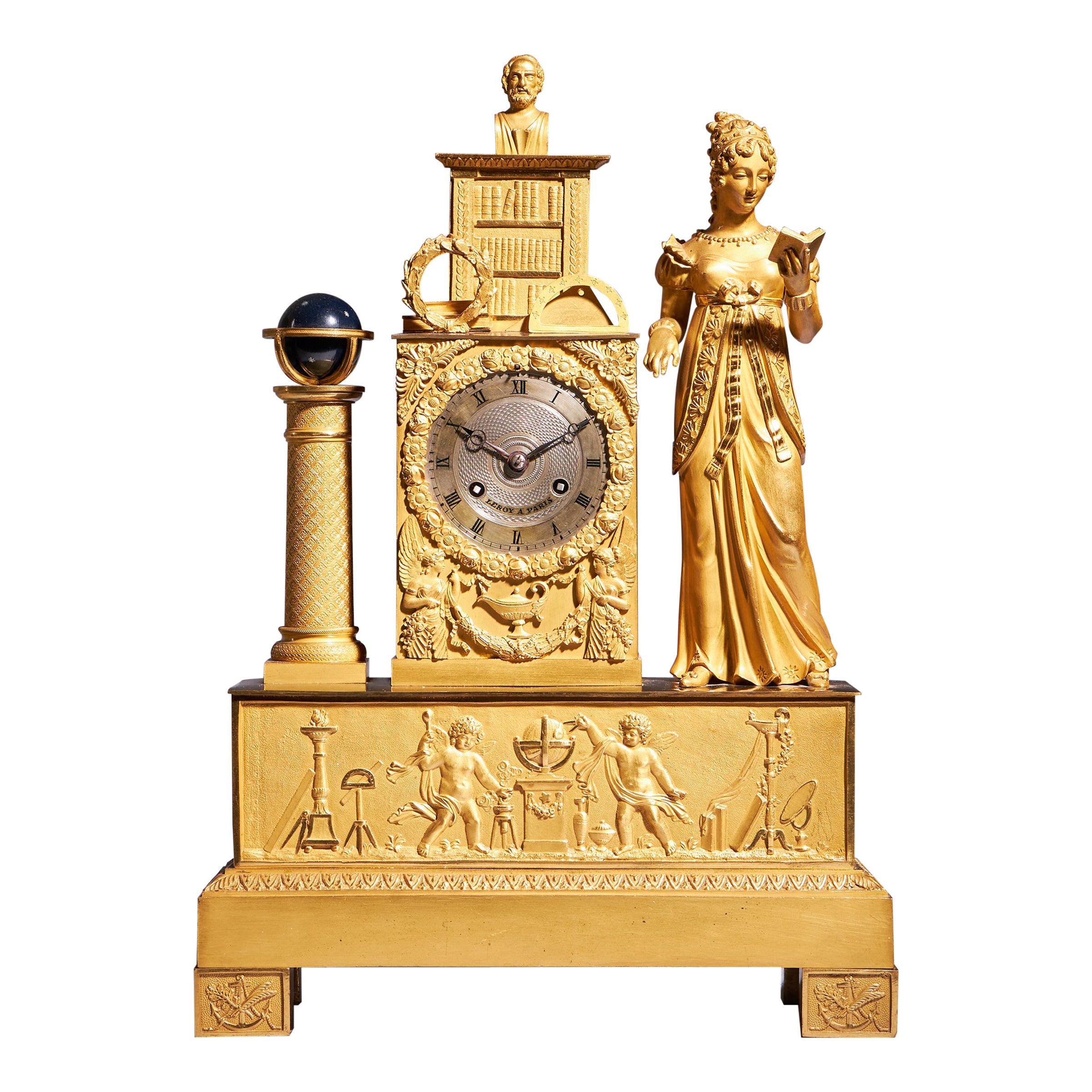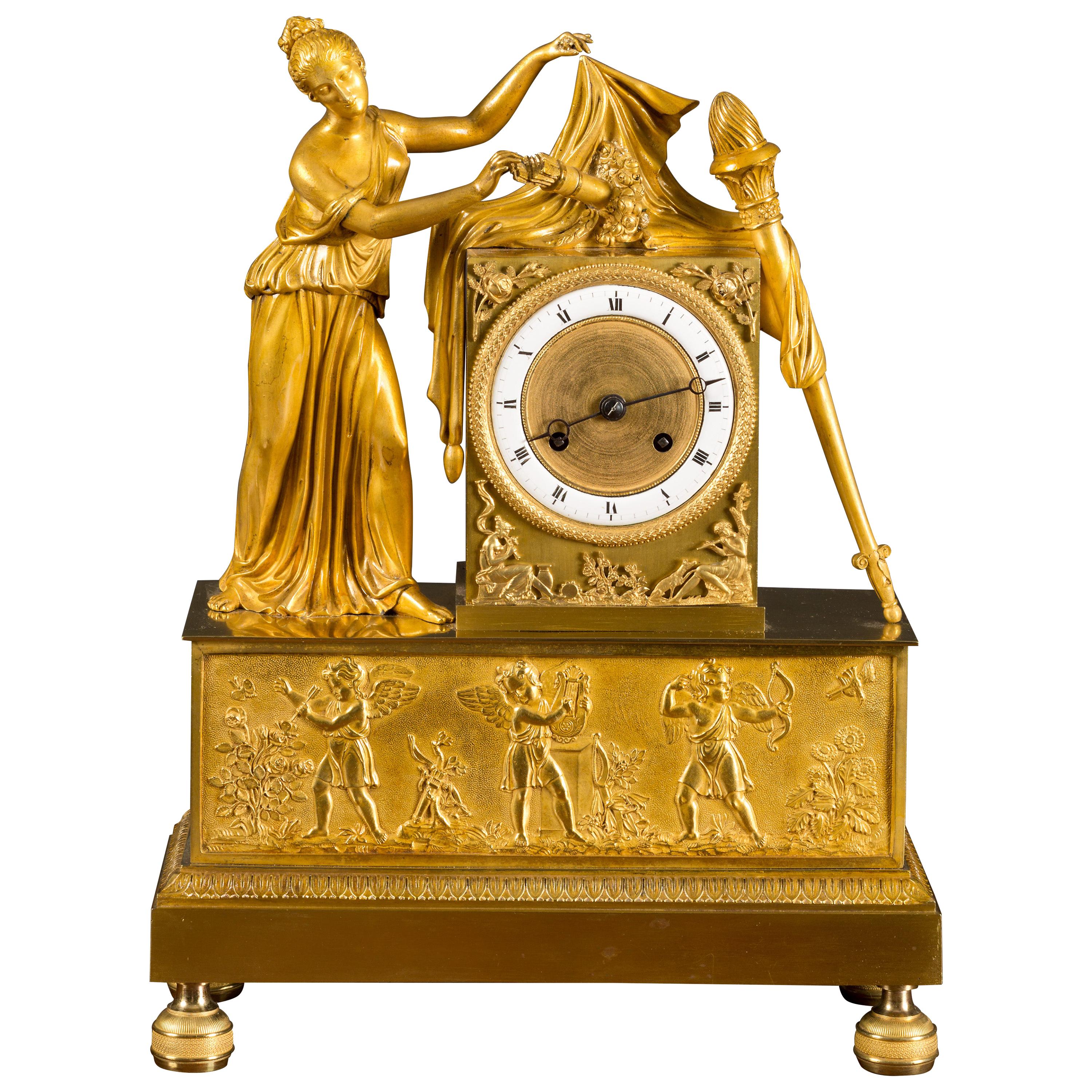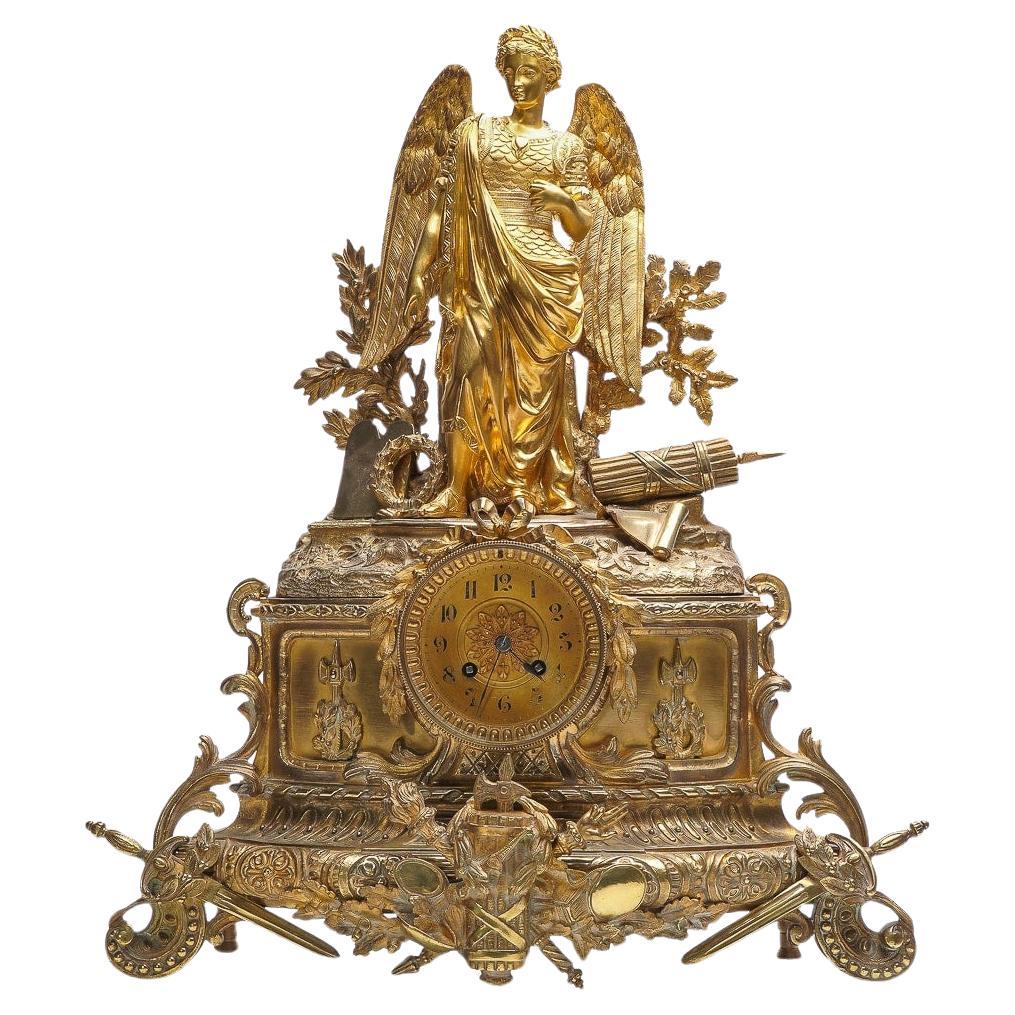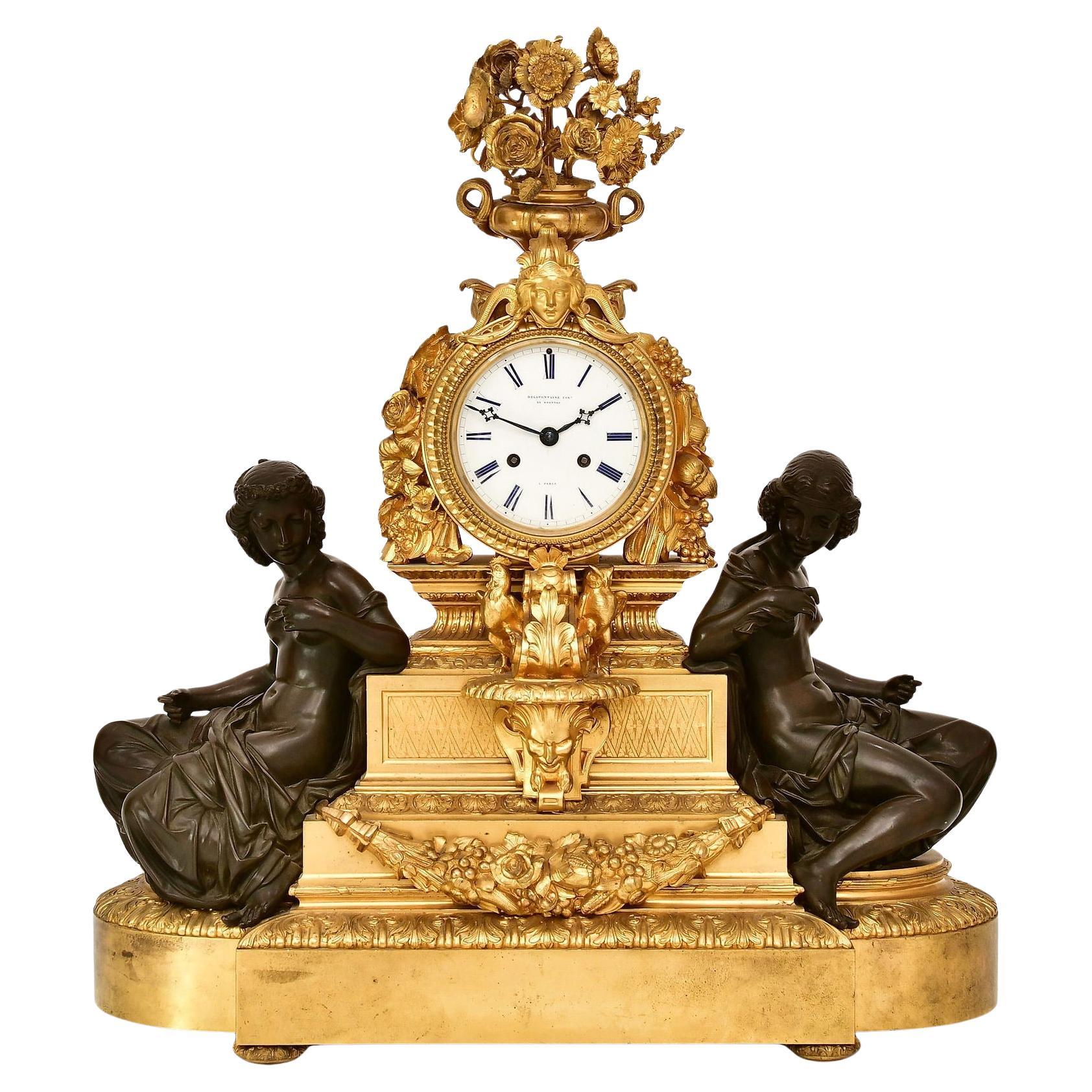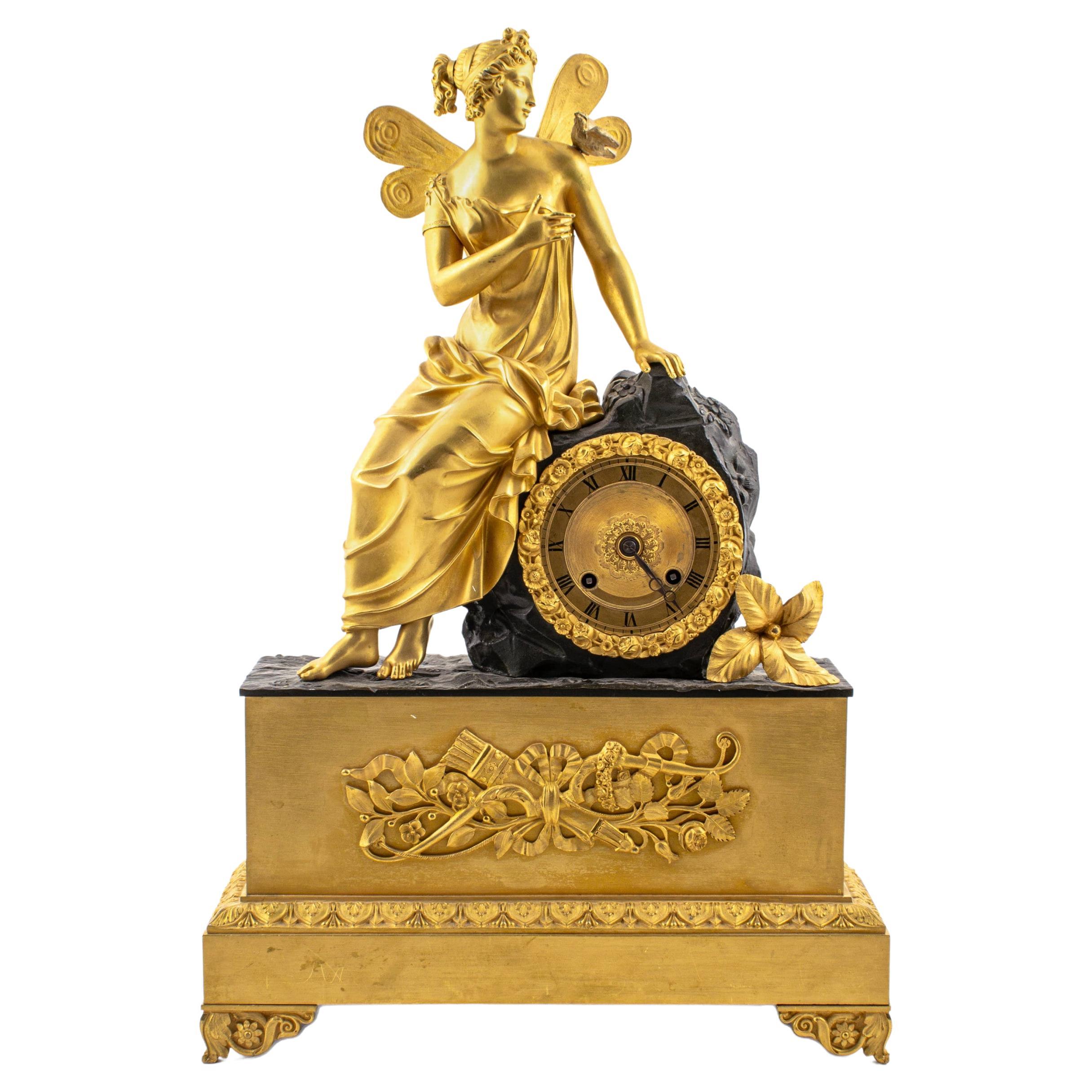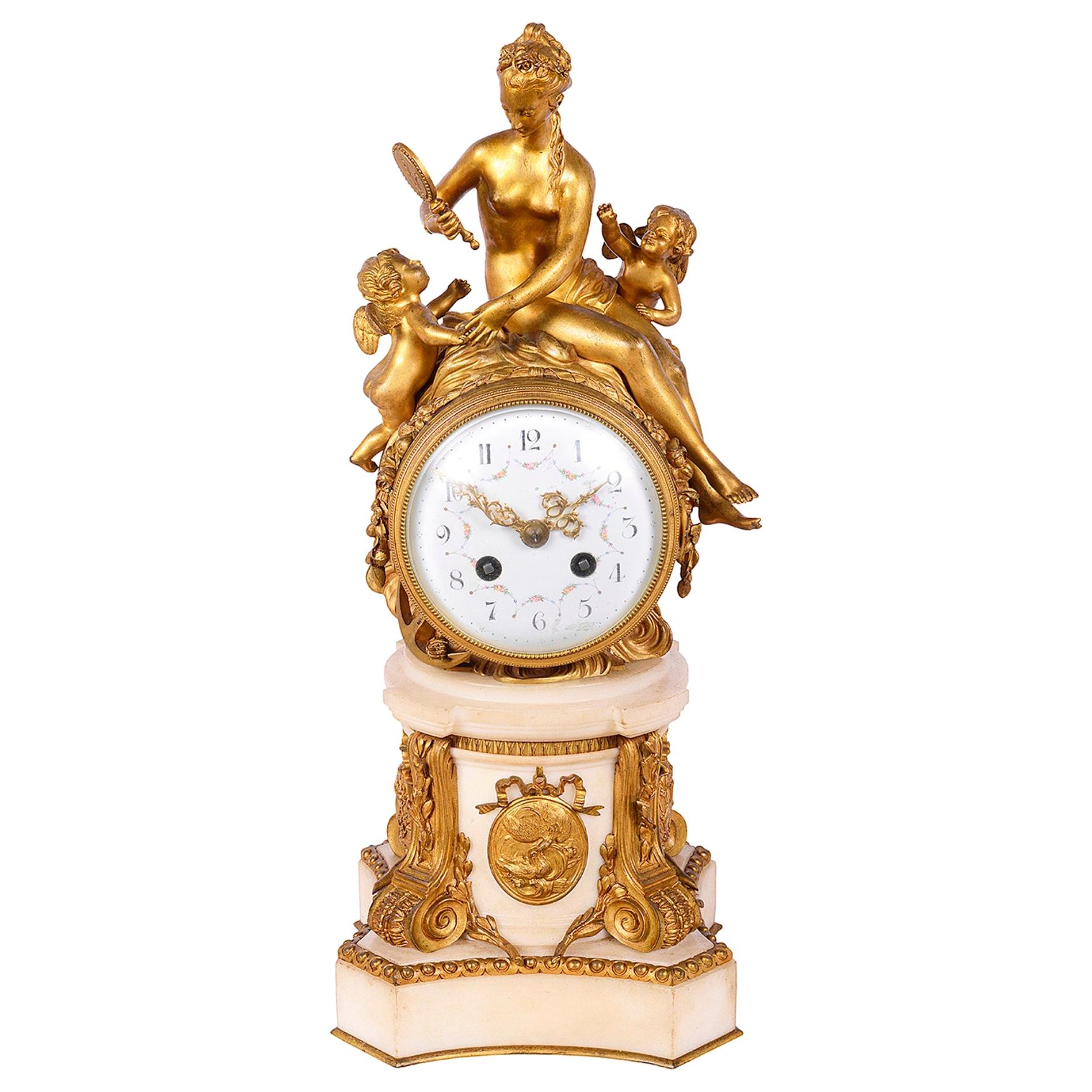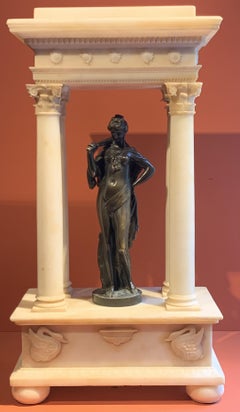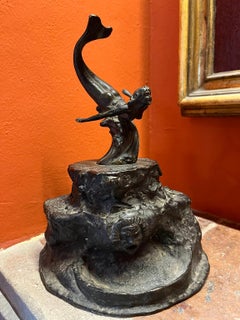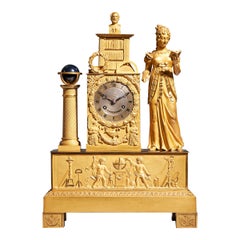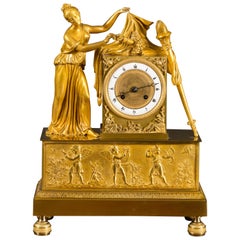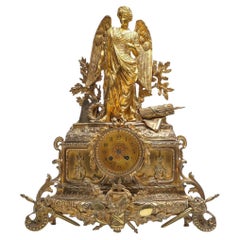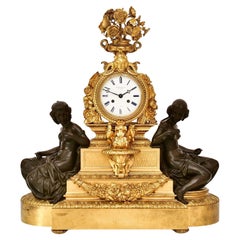Items Similar to Swiss French Imperial Neoclassic Mantel Clock 19th century
Want more images or videos?
Request additional images or videos from the seller
1 of 11
Honoré PonsSwiss French Imperial Neoclassic Mantel Clock 19th century1827
1827
$3,371.72
£2,494.65
€2,800
CA$4,662.01
A$5,118.30
CHF 2,670.23
MX$61,938.56
NOK 33,467.17
SEK 31,534.87
DKK 21,319.28
About the Item
Imperial Mantel Clock signed on the clock face “Renard suc(cursale) de Frissard, à Rouen”. It’s in gilded bronze and the mechanism is still working. The figure represents a lady wearing a peplum, sandals an a laurel wreath on the head. She’s holding a cartouche and she's in a relaxed pose, while a lyre is laying on the other side. For the attributes, we can identify her as Euterpe, the Muse of Music.
The Frissard were an originally Swiss family who became extremely important for the watchmaking. Their bases were in Normandy (Rouen) and in Paris. Between 18th and 19th century they were so praised that Napoleon himself requested their services, Renard was a branch office. The mechanism belongs to Honore Pons, who was an incredibly talented and famous watchmaker, who received several "gold medals", including one in the 1827, as reported inside.
About the Seller
5.0
Vetted Professional Seller
Every seller passes strict standards for authenticity and reliability
Established in 1958
1stDibs seller since 2019
30 sales on 1stDibs
Typical response time: 3 hours
- ShippingRetrieving quote...Shipping from: Florence, Italy
- Return Policy
Authenticity Guarantee
In the unlikely event there’s an issue with an item’s authenticity, contact us within 1 year for a full refund. DetailsMoney-Back Guarantee
If your item is not as described, is damaged in transit, or does not arrive, contact us within 7 days for a full refund. Details24-Hour Cancellation
You have a 24-hour grace period in which to reconsider your purchase, with no questions asked.Vetted Professional Sellers
Our world-class sellers must adhere to strict standards for service and quality, maintaining the integrity of our listings.Price-Match Guarantee
If you find that a seller listed the same item for a lower price elsewhere, we’ll match it.Trusted Global Delivery
Our best-in-class carrier network provides specialized shipping options worldwide, including custom delivery.More From This Seller
View AllAlabaster temple with mythological figurative bronze figure from the 19th century
Located in Florence, IT
Alabaster temple with Corinthian capitals, palmette decoration runs along the rim. On the front, two swans are carved on the base, while there are five rosettes at the top.
In the ce...
Category
Early 19th Century Romantic Figurative Sculptures
Materials
Alabaster, Bronze
Bronzetto italiano figurativo allegorico della fine del XIX secolo
Located in Florence, IT
Bronzetto firmato alla base F. de Luca, artista meridionale attivo fra XIX e XX secolo, raffigurante un'allegoria delle Arti.
In secondo piano, la "Scultura", identificata da un put...
Category
Late 19th Century Other Art Style Figurative Sculptures
Materials
Bronze
Italian Mannerist style Italian mythological figurative bronze statuette of the 20th century
Located in Florence, IT
The small bronze depicts a small seated faun, immortalized while playing a wind instrument as can be clearly seen by the puffy cheeks. is signed at the base R. Castagnino and is from...
Category
1930s Mannerist Figurative Sculptures
Materials
Bronze
Figurative bronze with a literary mythological theme from the early twentieth century
Located in Florence, IT
Early 20th-century Art Nouveau decorative bronze depicting a smiling mermaid carried by a wave above a fountain with a mask.
The reference is to the fairy tale by writer Hans Christ...
Category
Early 20th Century Art Nouveau Nude Sculptures
Materials
Bronze
Figurative mythological bronze statuette in Florentine Mannerist style of the 19th century
Located in Florence, IT
Small gilt bronze objet d'art on wooden base depicting a young sea creature, most likely a newt.
These types of objects were very common in aristocratic homes, often kept in the lord...
Category
Early 20th Century Other Art Style Figurative Sculptures
Materials
Bronze
Allegorical mythological figurative bronze from the 19th century
Located in Florence, IT
Marble-based bronze statuette depicting Cupid, holding an arrow in his hand, walking caressing a lion's mane, lowered in the act of affectionately licking his little foot. The subjec...
Category
Mid-19th Century Romantic Figurative Sculptures
Materials
Marble, Bronze
You May Also Like
Fine 19th century French ormolu mantel clock (pendule) by Leroy a Paris, c. 1825
By LeRoy
Located in Oxfordshire, United Kingdom
A most beautiful French ornolu mantel clock by Leroy à Paris
A lovely French late Empire/early Charles X mantel clock with an ormolu case, c. 1825. The ormolu brass case depicts a celebration of Science and Learning. It is dominated by a rectangular superstructure containing the movement, flanked by an engine-turned column with a celestial globe on top on the left and an elegant lady reading a book on the right. The superstructure is surmounted by a bookcase and a bust of Socrates...
Category
Antique Early 19th Century French Empire Mantel Clocks
Materials
Brass, Ormolu
French Ormolu Mantel Clock
Located in Norwich, GB
French ormolu mantel clock standing on a stepped base and resting on turned, chased feet with acanthus leaf decoration below a finely chased...
Category
Antique 1830s French Louis Philippe Mantel Clocks
Materials
Ormolu
19th Century French Empire Style Ormolu Bronze Mantel Clock, c.1870
Located in Royal Tunbridge Wells, Kent
Antique 19th Century French Empire style ormolu bronze mantle clock. The foliate surround gilt dial, Inside with eight day movement with strike on bell. The top mounted with a figure...
Category
Antique 19th Century French Mantel Clocks
Materials
Bronze, Ormolu
19th Century French Neoclassical Mantel Clock by Delafontaine of Paris
Located in New York, NY
Impressive and very fine quality mantel Louis XVI style clock, 28 by 26 by 12 1/2 inches, by Delafontaine of Paris with movement by Honore Pons.
Category
Antique Late 19th Century French Neoclassical Mantel Clocks
Materials
Bronze
Louis Phillippe Bronze Clock, France, c 1830-1840
Located in Kastrup, DK
Louis Phillippe gilded and dark patinated bronze clock.
Young woman adorned with wings and a bird on the shoulder sitting on rock block.
Gilt dial with wreath of flowers.
Included ke...
Category
Antique Mid-19th Century French Louis Philippe Mantel Clocks
Materials
Bronze
French 19th Century Classical Mantel Clock
Located in Brighton, Sussex
A very impressive 19th century classical French Louis XVI style mantel clock, having gilded ormolu figures of a naked maiden looking in a mirror with two cherubs to her side, above a...
Category
Antique Late 19th Century French Louis XVI Mantel Clocks
Materials
Marble, Ormolu
More Ways To Browse
French Neoclassical Art
Antique Swiss Clock
Swiss Antique Clocks Swiss Antique Clocks
Antique Clock Other Antique Clocks
19th Century French Lyre Clock
19th Century Swiss Clocks
Imperial Mantel Clock
Mantel Clock Bronze Imperial
Bruce King
Calder Scarf
Carol Craig
Cocaine Pop Art
Disney Celluloid
Disney Robin Hood
Elsa Ulbricht
Eric Stanton
Ferdinand The Bull
George Rodrigue Glass
